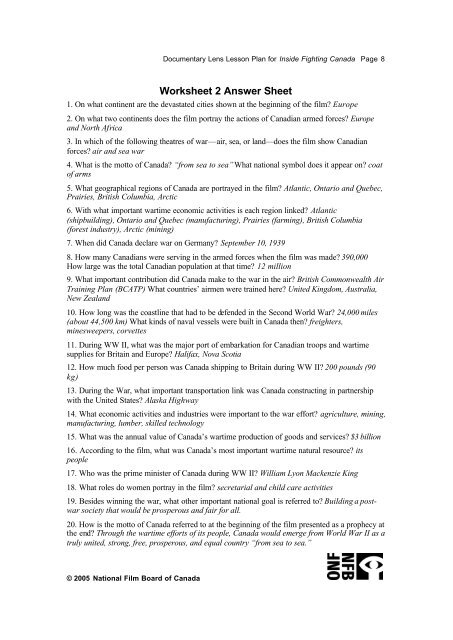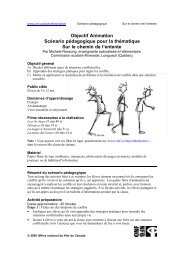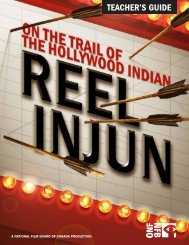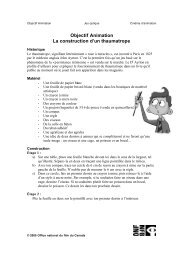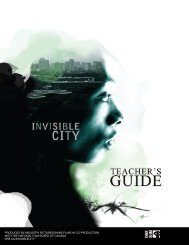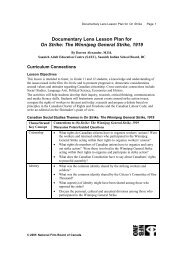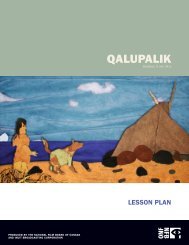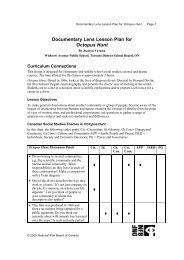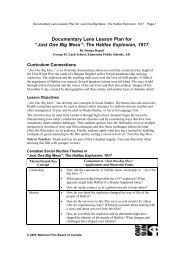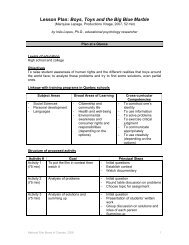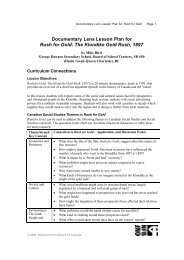Documentary Lens Lesson Plan for Inside Fighting Canada
Documentary Lens Lesson Plan for Inside Fighting Canada
Documentary Lens Lesson Plan for Inside Fighting Canada
- No tags were found...
Create successful ePaper yourself
Turn your PDF publications into a flip-book with our unique Google optimized e-Paper software.
<strong>Documentary</strong> <strong>Lens</strong> <strong>Lesson</strong> <strong>Plan</strong> <strong>for</strong> <strong>Inside</strong> <strong>Fighting</strong> <strong>Canada</strong> Page 8Worksheet 2 Answer Sheet1. On what continent are the devastated cities shown at the beginning of the film? Europe2. On what two continents does the film portray the actions of Canadian armed <strong>for</strong>ces? Europeand North Africa3. In which of the following theatres of war—air, sea, or land—does the film show Canadian<strong>for</strong>ces? air and sea war4. What is the motto of <strong>Canada</strong>? “from sea to sea” What national symbol does it appear on? coatof arms5. What geographical regions of <strong>Canada</strong> are portrayed in the film? Atlantic, Ontario and Quebec,Prairies, British Columbia, Arctic6. With what important wartime economic activities is each region linked? Atlantic(shipbuilding), Ontario and Quebec (manufacturing), Prairies (farming), British Columbia(<strong>for</strong>est industry), Arctic (mining)7. When did <strong>Canada</strong> declare war on Germany? September 10, 19398. How many Canadians were serving in the armed <strong>for</strong>ces when the film was made? 390,000How large was the total Canadian population at that time? 12 million9. What important contribution did <strong>Canada</strong> make to the war in the air? British Commonwealth AirTraining <strong>Plan</strong> (BCATP) What countries’ airmen were trained here? United Kingdom, Australia,New Zealand10. How long was the coastline that had to be defended in the Second World War? 24,000 miles(about 44,500 km) What kinds of naval vessels were built in <strong>Canada</strong> then? freighters,minesweepers, corvettes11. During WW II, what was the major port of embarkation <strong>for</strong> Canadian troops and wartimesupplies <strong>for</strong> Britain and Europe? Halifax, Nova Scotia12. How much food per person was <strong>Canada</strong> shipping to Britain during WW II? 200 pounds (90kg)13. During the War, what important transportation link was <strong>Canada</strong> constructing in partnershipwith the United States? Alaska Highway14. What economic activities and industries were important to the war ef<strong>for</strong>t? agriculture, mining,manufacturing, lumber, skilled technology15. What was the annual value of <strong>Canada</strong>’s wartime production of goods and services? $3 billion16. According to the film, what was <strong>Canada</strong>’s most important wartime natural resource? itspeople17. Who was the prime minister of <strong>Canada</strong> during WW II? William Lyon Mackenzie King18. What roles do women portray in the film? secretarial and child care activities19. Besides winning the war, what other important national goal is referred to? Building a postwarsociety that would be prosperous and fair <strong>for</strong> all.20. How is the motto of <strong>Canada</strong> referred to at the beginning of the film presented as a prophecy atthe end? Through the wartime ef<strong>for</strong>ts of its people, <strong>Canada</strong> would emerge from World War II as atruly united, strong, free, prosperous, and equal country “from sea to sea.”© 2005 National Film Board of <strong>Canada</strong>


